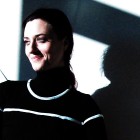
Beyond the techniques of mapping 3D/4D simulations on physical space, the construction of
immersive spatial experiences may find its foundation in polyvalent, cross-modal, synaesthetic
perception.
While development of mass media interfaces rely on the Euclidean model of space as the optimum,
the evolution of cognitive models of spatial representation in the context of art may continue towards
topological.
Using examples from Rubedo’s practice to explore the spatialisation of simulated, projected space,
the key concept is the role of the human body and mind as the mediator. Embodiment of the moving
image and 3D sound may be conducive to transformations of the Cartesian notion of space.
The key to embodiment of external, mediated space may be the error in perception process, leading
to ambiguous structures, fluid dimensional constructs and an augmented sense of being-in-space.
The link between illusion and immersion may be investigated according to several criteria, e.g.:
representation of space in the construction of immersive environments;
format and mediation: dissolution of borders between the mediated and the experienced content;
transmedia composition: creative strategies and performing techniques using cross-modal data
mapping.
The issues arising from constructing immersive environments invite further development of synchretic
multimedia art practices as well as interfaces for both the performer and the audience.
Curriculum Vitae
Dr Vesna Petresin Robert is Director of Rubedo, a London-based art practice and think tank founded she
founded in 2004 with Laurent-Paul Robert.
Vesna trained in classical music, architectural engineering and fine art and earned her Ph.D. in 2002 for a
dissertation on temporal aspects of composition in architecture, art and music.
She has worked as an artist, theorist, broadcaster, performer and designer, collaborated with Hypersurface Inc
(Columbia GSAPP) and published internationally. An academic since 1997, Vesna has lectured in architecture,
film, sound and visual theory, most recently at University College London and University of the Arts London. She
has been Advisor to the Deputy Chairman of Arup, producing innovation strategies and the acclaimed exhibition
The Frontiers of Architecture (Louisiana Museum of Modern Art), bridging aesthetics, engineering, acoustics and
number theory. She has been a Mentor and Speaker at the global new media network X|Media|Lab and Chair of
R&D programmes linking art, design and digital manufacturing.
Vesna is Fellow of the Royal Society of Arts, and Member of the R&D Society (RS)
Rubedo
explore relations between aesthetics, complex geometry, acoustics and synaesthesia, through
performance, installation and artefact.
The practice integrates sound, space, moving image and narrative using customised digital and analogue tools.
It takes art outside the ‘white cube’ experience and explores sound in relation to space, time and user
interaction. It is supported by cross-modal mapping of data networks, as well as composition techniques based
on the aleatory, emergent patterns and particle fields; these methods allow immediate creation in adaptive 3D/
4D environment and creative solutions for digital design (fashion and textiles industry, film production, product
design, construction and medicine). Topology becomes a vehicle for conceptualisation, concretisation and
symbolic mediation of the work that seeks to merge dual opposites of art and science, micro and macro,
intimate and collective.
Rubedo are recipients of industry and arts grants (British Council, UK Govt. Department of Innovation, Business
and Skills, Arts Council, Crafts Council) and acted as Industry Advisor to Goldsmiths College [Topology
Research Unit]. Their work has been awarded a hors-concours Critics Selection at the 44th International Film
Festival at Cannes, also contributing to team awards (Oscar, BAFTA, VES, Palme d’or) as well as patents and
the first non-commercial satellite.
The work recently featured at Tate Modern, Royal Academy of Arts, Royal Festival Hall, Venice Biennale, Cannes
International Film Festival, Institute of Contemporary Arts London, World Architecture Festival, Sydney Opera
House, Beijing Architecture Biennale, Venice Biennale, Kings Place and Vienna Secession.


